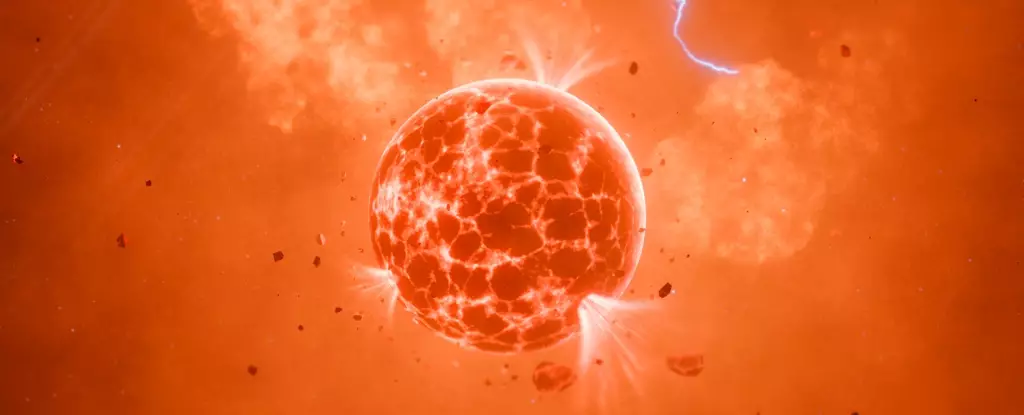In the vast expanse of the universe, some of the most tantalizing mysteries lie in the exploration of distant celestial bodies. A recent finding by astronomers has unveiled compelling evidence of a moon, characterized by intense volcanic activity, orbiting the gas giant, WASP-49b. Situated about 635 light-years from Earth, WASP-49b orbits a yellow dwarf star, WASP-49, and it is there that a giant cloud of neutral sodium has led researchers to hypothesize the existence of a volcanic exomoon. This discovery opens up new questions about the nature of moons in the universe and the mechanisms that could sustain such extraordinary geological phenomena.
The detection of sodium has proven instrumental in shaping the narrative around WASP-49b. Unlike terrestrial planets, gas giants are not typically associated with volcanic activity. Yet the sodium signatures were found to be disconnected from WASP-49b’s characteristics, suggesting an external influence—potentially a volcanic moon. Astrophysicist Apurva Oza and his team from the California Institute of Technology have underscored the vital importance of this sodium cloud, which appears to move contrary to the expected behavior if it were generated by the gas giant’s atmosphere. This anomalous motion strongly implies an origin from a body in orbit around WASP-49b, providing a compelling case for the existence of an exomoon.
The quest for exomoons has been fraught with challenges, primarily due to their diminutive size and the complex physical phenomena involved in their identification. Despite the discovery of nearly 300 moons in our own Solar System, evidence of extrasolar moons remains remarkably scarce. The mechanisms used to detect exoplanets are often ill-suited for finding their moons, resulting in the harsh reality that exomoons often evade observation. The case of WASP-49b exemplifies this dilemma, where initial findings focused on the planet itself rather than its potential companions, making the later realization of a volcanic moon more significant.
Prior to this revelation, research published in 2017 hinted at a sodium layer around WASP-49b, but it was Oza and his team’s analysis in 2019 that put forth the hypothesis of a volcanic exomoon. Historical cases of volcanic celestial bodies, such as Jupiter’s moon Io, provide a framework for understanding how this newfound moon may operate. An exomoon exhibiting volcanic activity could fundamentally transform our understanding of planetary systems, revealing the dynamic interactions between a planet and its accompanying satellites.
Through meticulous observation using the European Southern Observatory’s Very Large Telescope, researchers discovered that the sodium cloud around WASP-49b does not remain stable. Instead, this cloud appears intermittently, fluctuating in intensity and disappearing behind the planet and its star at irregular intervals. Such behavior poses further questions about its origin: Why would a volatile body like sodium appear in such a sporadic manner?
This intermittent presence suggests a continual process of sodium generation from volcanic activity, likely discharged from the exomoon—the hypothesis that provides the most satisfying explanation. The team’s analysis, informed by computer modeling, indicated that the sodium cloud’s appearance aligns closely with an exomoon orbiting WASP-49b approximately every eight hours, a revealing connection that strengthens the argument for its existence.
Drawing parallels with Jupiter and Io, Oza’s framework for understanding this exomoon suggests that gravitational forces play a pivotal role in its volcanic nature. Just as Io experiences immense tidal forces from its neighboring Galilean moons, the hypothetical moon of WASP-49b is likely subjected to gravitational pulls that induce geological activity. These forces could be compounded by the moon’s proximity to its planet, as the intense heat generated through this tidal interaction might drive the volcanic processes observed in the sodium emissions.
While examining the current findings, a sobering reality comes into view: the volcanic exomoon may have a limited lifespan. As it orbits the gas giant and continues to lose mass through volcanic eruptions, its trajectory may eventually spiral downward, leading to a cataclysmic end as it crashes into WASP-49b. Oza has postulated that if indeed such a moon exists, its demise will be a dramatic event in the cosmic narrative of this star system.
The implications of the discovery surrounding WASP-49b challenge our understanding of celestial bodies and their interactions. A volcanic exomoon would be a remarkable addition to the existing catalog of astronomical wonders, highlighting the need for further exploration into the composition and behavior of these intriguing satellites. As we refine our observational techniques and pursue the mysteries of the cosmos, findings like that of WASP-49b propel us toward a deeper understanding of the universe and our place within it.

